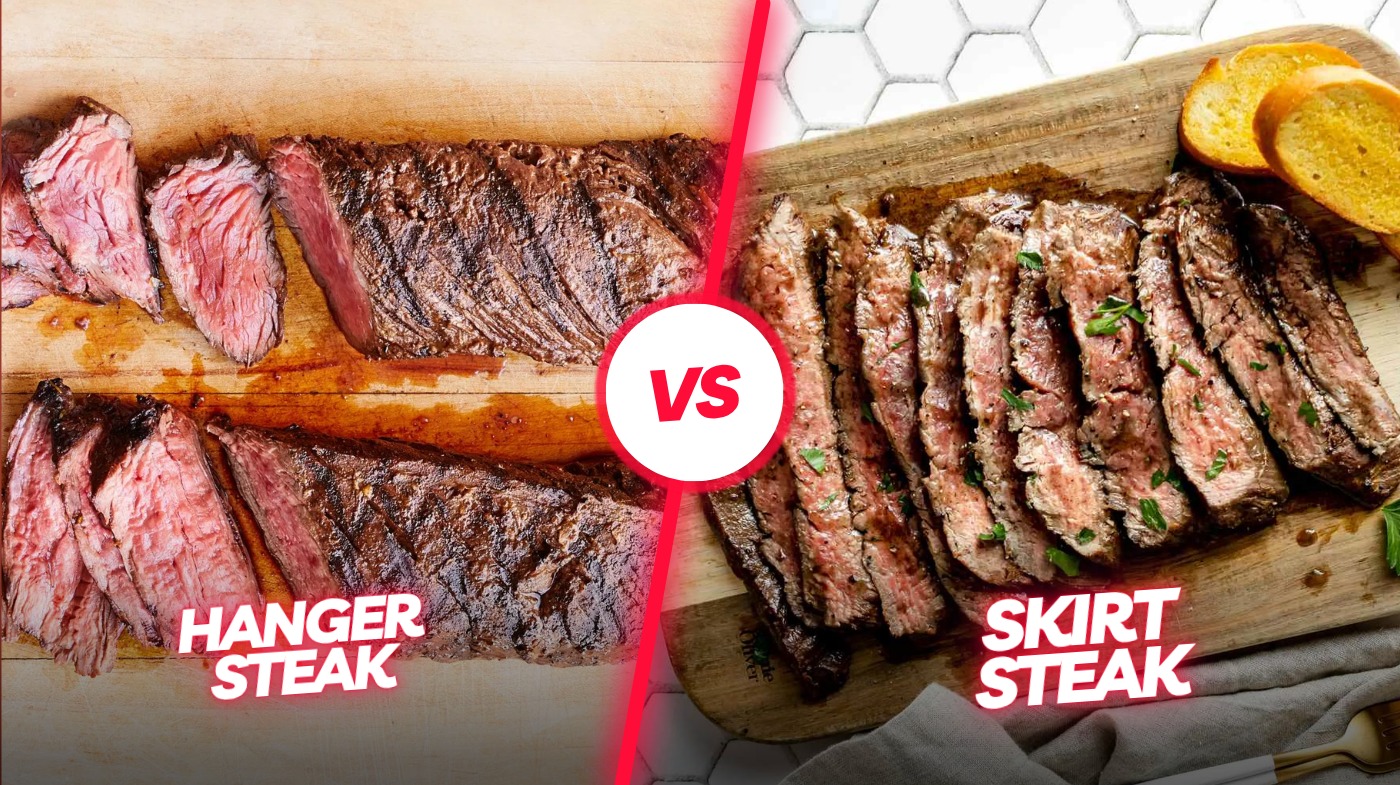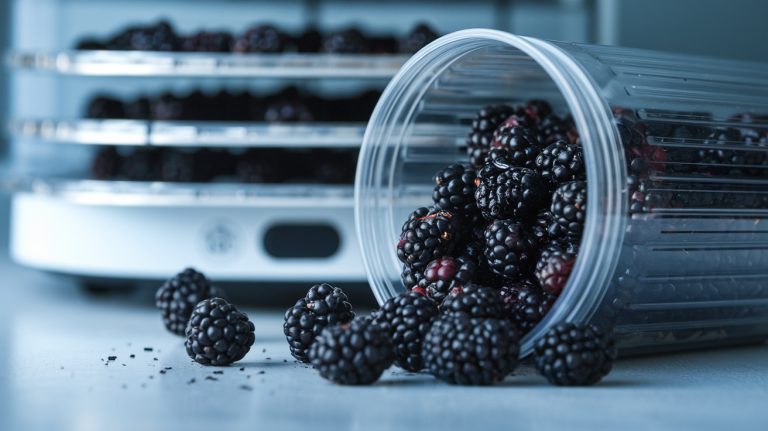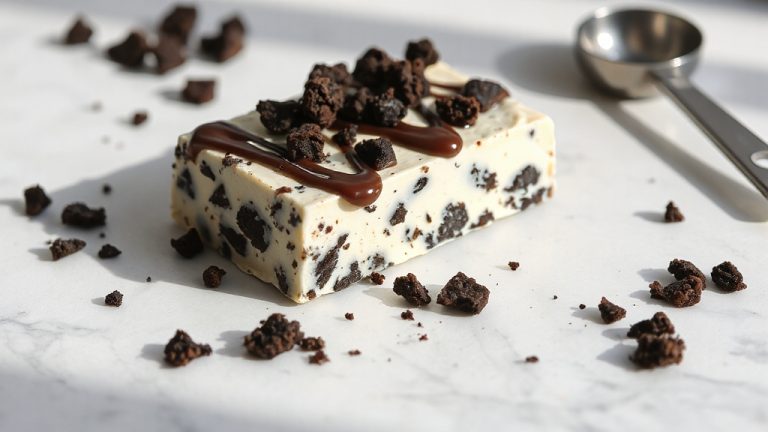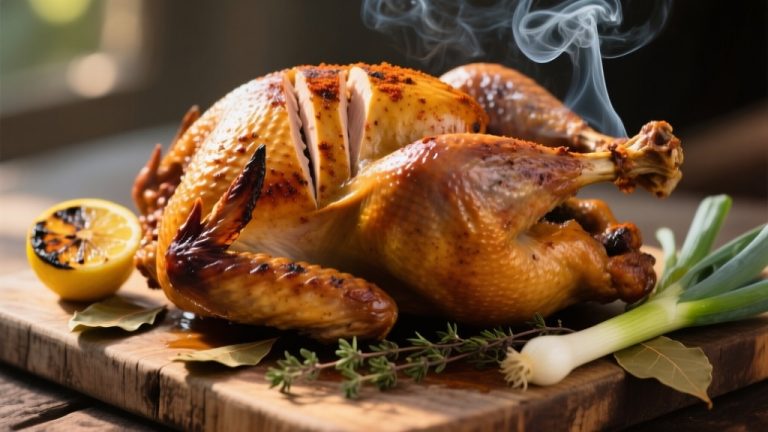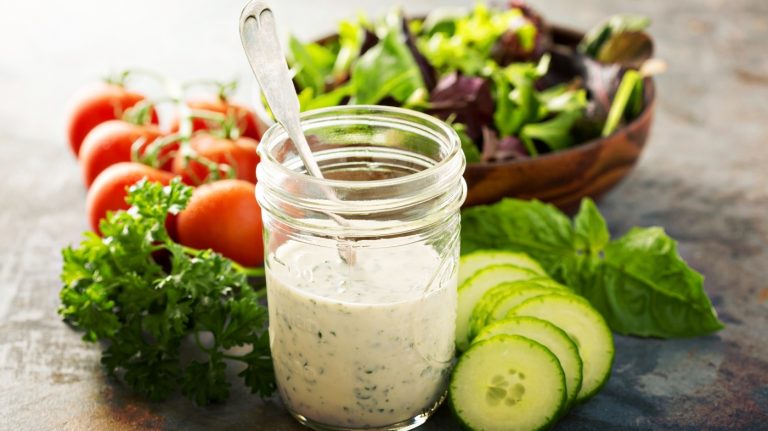Hanger vs Skirt Steak: Key Differences You Need to Know
You’ll find hanger steak, from the diaphragm’s crura, is thicker with marbling that boosts juiciness and tenderness, delivering bold, beefy flavor.
Skirt steak, from longer, thinner muscles, has a coarser texture and absorbs marinades well but is leaner and chewier.
Hanger steak suits quick searing and upscale dishes; skirt steak thrives with high heat and acidic marinades for casual meals. Understanding these differences helps you select the ideal cut and cooking method for your dish.
Key Takeaways
- Hanger steak is thicker with more marbling, offering a juicier, tender texture compared to the leaner, chewier skirt steak.
- Skirt steak is longer, thinner, and fibrous, ideal for marinating and quick, high-heat cooking like grilling or stir-frying.
- Hanger steak delivers a bold, gamey beef flavor, while skirt steak has a robust but milder taste, absorbing marinades well.
- Hanger steak is rare and pricier, suitable for upscale meals, whereas skirt steak is more affordable and great for casual, shared dishes.
- Both require slicing against the grain for tenderness, with hanger steak cooked medium-rare and skirt steak benefiting from marination.
Hanger vs Skirt Steak – Essential Comparison Table
| Aspect | Hanger Steak | Skirt Steak |
|---|---|---|
| Availability | Only one per animal – rare and premium | Two cuts per cow – widely available |
| Texture | Fine, tender with loose fibers | Coarse, chewy with dense fibers |
| Flavor | Intense, bold beefiness with gamey notes | Robust but milder, absorbs marinades well |
| Pricing | Premium pricing – comparable to ribeye | More affordable and budget-friendly |
| Best Cooking Method | High-heat searing (3-4 minutes per side) | Extremely high heat with marinating required |
| Ideal Temperature | Medium-rare (130-135°F) | Medium-rare with quick cooking |
| Slicing | Slice against grain in thicker cuts | Slice thinly against grain at 45° angle |
| Best Uses | Upscale dishes, special occasions | Fajitas, casual meals, shared dishes |
Origin and Location of Hanger and Skirt Steak
When you examine the origin and location of hanger and skirt steaks, you’ll find they both come from the cow’s plate section but differ anatomically and functionally.
The hanger steak, or “onglet,” is a single muscle derived from the diaphragm’s crura, hanging between the last rib and lumbar vertebrae near the lower belly.
It’s centrally positioned and less worked, contributing to its tenderness. It is also attached to the last rib and several lumbar vertebrae, with the right side being larger and stronger than the left, which influences its texture and flavor (anatomical attachment).
The hanger steak, known as onglet, is a tender, centrally located muscle from the diaphragm’s crura.
In contrast, the skirt steak originates from two muscles: the outside skirt from the diaphragm’s outer muscle and the inside skirt from the plate muscle beneath the ribs near the flank. These muscles are longer, thinner, and more exercised due to their role in breathing, resulting in a tougher texture.
Physical Characteristics Comparison
Physical differences between hanger and skirt steaks greatly influence their culinary uses and preparation methods.
The hanger steak is thicker, weighing 8 to 16 ounces, with a compact, flat rectangular shape. It has fine, open-grained muscle fibers and significant intramuscular marbling, contributing to its juiciness and tenderness. Only one hanger steak is available per animal, which makes it a rare and prized cut.
In contrast, the skirt steak is longer, thinner, and narrower, featuring pronounced, coarse muscle fibers and less internal marbling but a higher external fat layer.
Hanger steak comes from a less-used supportive muscle, making it inherently more tender, while skirt steak originates from a more active diaphragm muscle, resulting in a chewier texture.
Physically, hanger steak requires less trimming, whereas skirt steak often demands membrane removal due to its irregular shape and visible muscle fibers, affecting how you prepare each cut.
Flavor Profiles of Each Cut
Understanding the distinct textures and muscle compositions of hanger and skirt steaks sets the stage for appreciating their unique flavor profiles.
Recognizing the unique textures and muscles of hanger and skirt steaks deepens appreciation of their flavors.
You’ll find hanger steak delivers an intense, bold beefiness with a slightly gamey undertone, enhanced by its natural fat infiltration and marbling, especially in premium cuts like Akaushi Wagyu.
This fat contributes to juiciness and a rich mouthfeel, making hanger steak ideal for dishes where depth is key. Known as the butcher’s steak, hanger steak was historically reserved for butchers due to its prized flavor and tenderness.
In contrast, skirt steak offers a robust but less intense flavor, leaner with minimal marbling but rich in connective tissue that adds flavor when cooked properly. Its fibrous texture allows it to absorb marinades effectively, boosting versatility in spiced preparations like fajitas or stir-fries.
Both cuts excel in beef flavor, yet hanger steak stands out for richness and complexity.
Texture Differences Between Hanger and Skirt Steak
Although both hanger and skirt steaks originate from the diaphragm area, their textures differ markedly due to variations in muscle fiber structure and density.
Hanger steak exhibits a fine, open-grained texture with somewhat loose fibers, allowing marinade penetration and yielding a balance of tenderness and slight fibrousness.
Its pronounced marbling further enhances juiciness and softness. Located in the beef’s plate section, hanger steak is prized for its robust, beefy flavor which distinguishes it from other cuts.
In contrast, skirt steak has a coarser, denser fiber arrangement running longitudinally, resulting in a tougher, chewier mouthfeel. This cut’s tightly packed long muscle fibers demand rapid, high-heat cooking and careful slicing against the grain to mitigate toughness.
Additionally, skirt steak’s lower intramuscular fat content intensifies its firmness, whereas hanger steak’s fibrous yet tender nature depends on precise cooking to avoid toughness, reflecting their distinct anatomical origins within the diaphragm muscles.
Availability and Pricing Factors
Because hanger steak is limited to just one cut per animal and requires specialized butchering, you’ll find it far less available than skirt steak. It is prized for its rich, beefy flavor, which adds to its exclusivity.
Skirt steak, with two cuts per cow, enjoys wider distribution through grocery stores and supermarkets, making it more accessible and affordable.
Consider these factors influencing availability and pricing:
- Hanger steak is sourced mainly by specialty butchers, often labeled as “butcher’s steak,” impacting supply.
- Skirt steak’s larger size and dual availability per animal increase its market presence.
- Hanger steak’s premium status and rarity drive higher prices, often comparable to ribeye.
- Skirt steak’s popularity in casual and ethnic cuisines stabilizes its competitive pricing.
Your choice depends on balancing exclusivity and cost-efficiency for your culinary needs.
Best Cooking Techniques for Hanger Steak
You’ll want to cook hanger steak to an internal temperature of 130-135°F for ideal medium-rare doneness, using a reliable meat thermometer to monitor progress.
Aim for high-heat searing of about 3-4 minutes per side to develop a rich crust without overcooking the interior. After cooking, rest the steak for 10 minutes and slice it thinly across the grain to maximize tenderness and flavor retention.
For the best results, it is essential to properly trim the steak by removing the silver skin, excess fat, and connective tissue before cooking.
Optimal Temperature Range
Mastering the ideal temperature range is essential for cooking hanger steak to perfection, as it directly influences tenderness, flavor, and safety. Aim for an internal temperature between 130°F and 135°F (54°C to 57°C) to achieve medium-rare, ensuring best juiciness and flavor.
Hanger steak is known for its quick cooking time, making precise temperature control especially important to avoid overcooking.
The USDA mandates a minimum of 145°F (63°C) for safety, but this medium range balances texture and risk effectively.
To maintain this range, follow these steps:
- Sear the steak at high heat (~400°F) for 1.5 to 2 minutes per side to lock juices.
- Use an instant-read thermometer in the thickest section for precise monitoring.
- Remove the steak a few degrees below the target to allow carryover heat.
- Let it rest 5-10 minutes, enabling temperature equilibration and juice redistribution. This resting period is crucial to redistribute juices and enhance tenderness.
Ideal Cooking Duration
When searing hanger steak, aim for 2 to 3 minutes per side over high heat to develop a rich browned crust while preserving interior juiciness. This initial sear triggers the Maillard reaction, enhancing flavor without compromising tenderness.
Because hanger steak is a very tender cut due to minimal muscle stress, quick searing ensures it remains tender and flavorful.
Typically, total stovetop or grill cooking spans 4 to 6 minutes for medium-rare doneness. After searing, you can transfer the steak to a 350°F oven for 5 to 10 minutes to evenly raise internal temperature to 120°F–130°F, ensuring medium-rare to medium doneness.
Use an instant-read thermometer to monitor internal temperature precisely, accounting for 5°F carryover heat post-cooking. Preparing the steak at room temperature beforehand optimizes cooking time and uniformity.
Avoid overcooking in the oven to prevent toughness; instead, rely on searing combined with controlled oven finishing for ideal texture and flavor.
Resting and Slicing
After achieving the perfect sear and internal temperature, allowing the hanger steak to rest becomes a key step in preserving its juiciness and texture.
Resting for 5 to 10 minutes under a loose foil tent lets juices redistribute evenly, preventing moisture loss and maintaining tenderness. Hanger steaks are known for their meaty taste and open texture, which this resting process helps preserve.
When slicing, always cut against the grain with a sharp knife to guarantee clean, tender bites.
For ideal results:
- Rest the steak at room temperature pre-cooking for even heat penetration.
- Remove steak from heat a few degrees below target doneness to account for carryover cooking.
- Let the fibers relax fully during resting to lock in moisture.
- Slice hanger steak into thicker cuts against the grain to balance juiciness and robust texture.
Ideal Cooking Methods for Skirt Steak
You’ll want to cook skirt steak over intense, high heat to quickly develop a flavorful crust while preserving juiciness.
Marinating beforehand breaks down muscle fibers, enhancing tenderness and flavor absorption. Skirt steak is a lean, thin cut from the diaphragm muscles of the cow that benefits greatly from marination due to its tough fibers.
After cooking, slice thinly against the grain to shorten muscle fibers and maximize tenderness.
High Heat Techniques
Although skirt steak’s thin, lean profile demands careful handling, applying extremely high heat is essential to achieve a flavorful crust while maintaining tenderness. You want to sear the meat rapidly to lock in juices and develop a deep browning without overcooking the interior.
Use a blazing hot grill, cast iron skillet, or broiler preheated to around 700°F (370°C). This high-heat cooking method retains juiciness and enhances flavor, making it ideal for skirt steak. Follow these steps for ideal results:
- Pat the steak dry and bring it to room temperature before cooking.
- Sear each side for 2-3 minutes—adjust time based on thickness.
- Monitor browning closely to prevent burning; reduce heat if needed.
- Rest the steak 10 minutes post-cooking, then slice against the grain for maximum tenderness.
This hot-and-fast technique preserves juiciness and produces a robust crust critical for skirt steak’s flavor.
Marinating Benefits
When marinating skirt steak, incorporating acidic or enzymatic ingredients softens its dense muscle fibers, greatly enhancing tenderness and juiciness. Acids like vinegar or citrus juice break down collagen, while enzymes from pineapple or papaya further degrade tough connective tissue.
A marinade balancing salt, acidity, and oil guarantees flavor penetration and moisture retention. Even a 30-minute soak initiates tenderizing; extending to 2 hours or overnight maximizes flavor depth and texture improvement.
Salt in the marinade modifies proteins, aiding moisture retention during cooking. Use airtight containers to fully coat the meat and refrigerate to maintain freshness.
After marinating, let excess drip off to prevent flare-ups. This preparation primes skirt steak for high-heat cooking methods, preserving juiciness and enhancing its naturally bold beef flavor.
Slicing Against Grain
Mastering the slicing technique for skirt steak markedly impacts its texture and overall eating experience. The key lies in slicing against the grain, which shortens long muscle fibers, enhancing tenderness and chewability.
Here’s how to execute it precisely:
- Identify the grain’s direction—parallel muscle fibers running lengthwise—and cut the cooked steak into 4-6 inch manageable sections.
- Rotate each section 90 degrees to the grain, ensuring your slices run perpendicular to the fibers. This step is crucial because the outside skirt steak comes from the diaphragm area, known for its strong muscle.
- Use a sharp knife to slice thinly at a 45-degree angle, maximizing tenderness and flavor absorption.
- Rest the steak briefly post-cooking to retain juices before slicing, preserving texture and preventing toughness.
Culinary Uses and Dish Pairings
Because hanger and skirt steaks each possess distinct textures and flavor profiles, their culinary uses and ideal pairings differ considerably.
You’ll want to marinate hanger steak with olive oil, garlic, and herbs, then grill or pan-sear it quickly to retain its tenderness. It is important to remove the membrane from the hanger steak before marinating to enhance tenderness.
Slice it thinly against the grain and serve with herbaceous chimichurri or rich bagna cauda sauces, alongside roasted potatoes or grilled vegetables. Robust red wines enhance its beefy intensity.
For skirt steak, focus on acidic or spicy marinades like lime or chipotle to tenderize and complement its coarse texture.
Cook it quickly to medium-rare, slice thinly across the grain, and use it in fajitas or stir-fries with fresh salsas, pickled slaws, and traditional sides like rice and beans—these balance its robust flavor perfectly.
Substitution Tips Between Hanger and Skirt Steak
Although hanger and skirt steaks come from nearby sections of the cow, their distinct physical characteristics and textures demand careful consideration when substituting one for the other.
Hanger and skirt steaks are close cuts but differ enough to require thoughtful substitution.
You’ll want to adjust cooking methods and preparation to maintain the desired tenderness and flavor profile.
- Account for hanger steak’s thickness and tenderness by reducing cooking time compared to skirt steak. Hanger steak is more tender than skirt steak due to less strenuous muscle use.
- Slice both steaks thinly across the grain to counteract skirt steak’s chewier texture and preserve hanger steak’s tenderness.
- Modify marinating duration: longer for skirt steak to tenderize, shorter or optional for hanger steak due to its natural tenderness.
- Expect flavor shifts—hanger steak offers a richer, iron-like taste, while skirt steak provides a bolder, robust flavor ideal for marinades.
Choosing the Right Cut for Your Meal
When selecting between hanger and skirt steak, focus on how their distinct flavor profiles and textures align with your dish’s needs—hanger offers tenderness and a rich, iron-tinged taste, while skirt provides a chewier bite with pronounced grain.
Hanger steak is known as the butcher’s steak because it was traditionally kept by butchers for its beefy flavor and tender texture. Consider cooking methods: hanger steak excels with medium-rare grilling or pan-searing to preserve juiciness, whereas skirt steak benefits from marinating and quick, high-heat cooking for ideal tenderness.
Finally, match your choice to the meal occasion—reserve hanger for feature dishes on special occasions and opt for skirt when preparing versatile, budget-friendly meals for larger groups.
Flavor and Texture Differences
If you want to maximize beef flavor and tenderness in your dish, choosing between hanger and skirt steak hinges on understanding their distinct profiles.
Hanger steak boasts an ultra-rich, beefy flavor with a tender, compact texture, while skirt steak delivers robust flavor with a chewier, fibrous bite.
Consider these factors:
- Flavor Intensity: Hanger offers depth akin to premium cuts; skirt is bold but less nuanced.
- Texture: Hanger is tender due to low muscle activity; skirt’s longer fibers require slicing against the grain to reduce chewiness. It is important to note that hanger steak has a thick inedible membrane that must be removed before cooking.
- Cut Dimensions: Hanger is thicker and shorter, promoting juiciness; skirt is thin and broad, enabling quick cooking and thin slicing.
- Dish Suitability: Use hanger for steak-centric plates; skirt excels in marinated, high-heat recipes needing thin beef strips.
Cooking Techniques Comparison
Selecting the right cooking technique for hanger or skirt steak depends largely on their structural differences and thickness.
Hanger steak’s thicker, loosely grained muscle benefits from high-heat grilling or pan-searing above 400°F, allowing a seared crust while retaining juiciness. Butterflying the remaining loins is recommended for even cooking.
Basting with butter and herbs during pan-cooking enhances flavor penetration. After cooking to medium-rare (~135°F), rest it for 10 minutes to redistribute juices before slicing against the grain.
Skirt steak, being thinner and fibrous, requires rapid searing on both sides for 2-3 minutes at high heat to develop a crust without overcooking. The hanger steak comes from the diaphragm of a cow. Brief resting suffices due to its thinness.
Marinating both cuts tenderizes and flavors, but skirt steak demands precise slicing to counter toughness.
Meal Occasion Suitability
Because hanger and skirt steaks differ greatly in flavor, texture, size, and cost, choosing the right cut depends on the meal occasion you’re planning.
You’ll want hanger steak for intimate, upscale dinners where tender, beefy flavor shines without heavy sauces. Skirt steak suits casual, large-group meals requiring affordability and bold seasoning.
Consider these factors:
- Hanger steak’s smaller size and premium cost make it ideal for plated, special-occasion meals. Its unique availability as only one per steer adds to its exclusivity.
- Skirt steak’s length and affordability support shared dishes like fajitas or stir-fries.
- Use hanger steak when emphasizing meat quality with simple accompaniments.
- Choose skirt steak for heavily marinated, textured dishes in everyday or ethnic-themed menus.
Frequently Asked Questions
Can Hanger and Skirt Steaks Be Frozen Without Losing Quality?
You can freeze both hanger and skirt steaks without losing quality if you follow precise methods. Vacuum-seal or tightly wrap them to prevent air exposure and freezer burn. Freeze promptly and store flat, labeling dates for tracking.
Keep freezing durations within 3-6 months to avoid flavor and texture degradation. Thaw slowly in the refrigerator to minimize moisture loss. Proper handling preserves tenderness, flavor, and texture effectively, ensuring near-fresh quality after freezing.
How Should Hanger and Skirt Steaks Be Stored Before Cooking?
You should refrigerate raw steaks at or below 40°F, wrapping them tightly in plastic or airtight containers to prevent air exposure and contamination.
Use fresh steaks within 3–4 days or freeze them for 2–3 months. Thaw frozen steaks overnight in the refrigerator.
Marinate in the fridge, then let steaks sit at room temperature before cooking—30 minutes for hanger, 20–30 for skirt. Always pat dry and trim excess fat before cooking.
Are Hanger and Skirt Steaks Safe to Eat Rare or Medium-Rare?
Imagine serving a steak to guests only to hear one fall ill later from undercooked meat. You can safely enjoy steaks rare or medium-rare if you reach USDA’s internal temperature of 145°F and rest the meat for 3 minutes.
Hanger steak is best at medium-rare for texture, but avoid rare. Skirt steak’s fibrous nature means you should cook it slightly beyond rare. Always avoid needle-tenderized cuts at rare doneness.
What Marinades Best Enhance Skirt Steak’S Flavor and Tenderness?
You’ll want to use a marinade that combines acidic components like lemon juice or balsamic vinegar to tenderize skirt steak’s dense fibers effectively.
Incorporate umami-rich elements such as soy sauce and Worcestershire sauce to deepen flavor complexity. Add olive oil for moisture retention and herbs like Italian seasoning for aromatic enhancement.
Marinate for at least two hours, ideally overnight, ensuring even flavor absorption without compromising the meat’s texture.
Do Hanger and Skirt Steaks Have Different Nutritional Values?
You’ll find hanger and skirt steaks have very similar nutritional profiles. Both offer high protein, zero carbs, and are rich in Vitamin B12 and iron. Their saturated fat and cholesterol contents are comparable, though slight variations depend on trimming and thickness.
Skirt steak has marginally higher protein, but both cuts require moderation due to fat levels. Cooking methods and fat trimming can influence their final nutritional impact on your diet.
Choose the Right Steak to Elevate Your Culinary Experience
When choosing between hanger and skirt steak, you’re selecting more than just meat—you’re picking a flavor journey. Hanger steak, with its robust, beefy depth and tender chew, contrasts the skirt steak’s bold, fibrous texture and intense taste.
Understanding their origins, cooking methods, and price points guarantees you wield the perfect cut for your dish. Like a finely tuned instrument, each steak sings best when matched to its ideal culinary stage.

